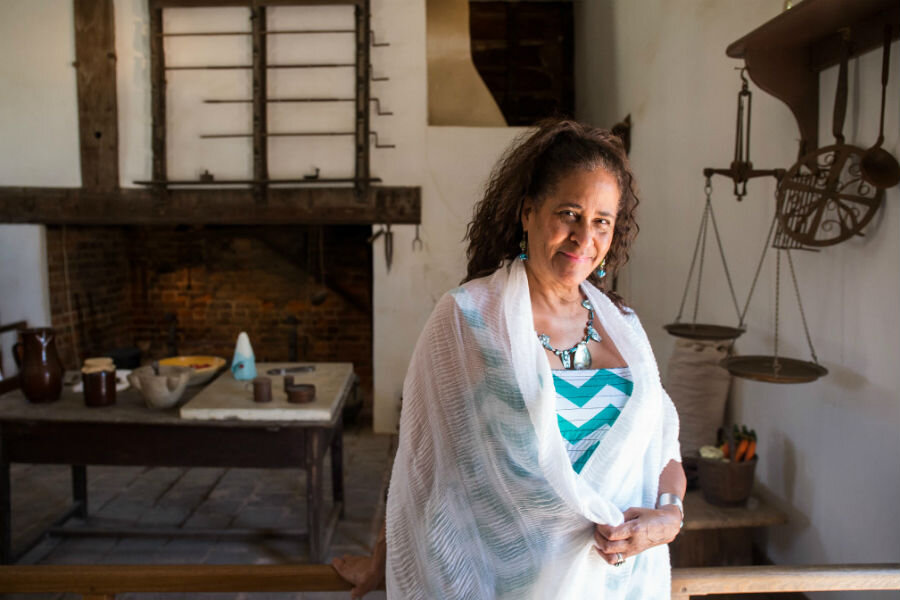New Mount Vernon exhibit puts a face to George Washington's slaves
Loading...
A walk through the newest exhibit at Mount Vernon offers a glimpse into the lives of the less frequently acknowledged residents of George Washington's plantation home: his slaves.
Hundreds of years after the first First Family inhabited Mount Vernon, the 317 slaves who lived and worked there have been recognized in an exhibit at the Donald W. Reynolds Museum titled "Lives Bound Together: Slavery At George Washington's Mount Vernon." The exhibit features the backstories of 19 individual slaves and aims to provide a better understanding of the way those who were enslaved there interacted with the plantation and supported and provided for President Washington and his family.
The opening of the exhibit coincides with confirmation of the rumors that have swirled around the first president's family tree for more than 200 years: that the Washingtons' adopted son, who went by "Wash," fathered biracial children with two of Washington's slaves. The exhibit also comes as the history of slavery has begun to gain greater recognition from the American public: the country's first National Museum of African American History and Culture, featuring relics from the slave era, opened last month, and a number of universities and other institutions have publicly acknowledged the role that slaves played on campus.
The exhibit at Mount Vernon came together with the help of some of the descendants of Washington's slaves, who contributed advice, observations, and family stories to supplement the information on record.
One descendant, Rohulamin Quander, told NPR that the purpose of the exhibit is not to sugarcoat the lives of slaves at Mount Vernon.
"We were focused more on telling the story of those who lived through the experience and achieved what they did achieve despite the impact of the experience," Mr. Quander said. "We wanted to show them, despite the fact that they had very little to no education, we wanted to show them as real people and we wanted to show them in the context of how they survived in spite of everything."
George Washington's relationship with his slaves evolved over his lifetime, leaving him conflicted about the institution at the time of his death. As Amanda Hoover reported for The Christian Science Monitor last month:
As a strict plantation manager driven by efficiency, Washington was sometimes deemed a harsh slave owner in the beginning of his career, with his neighbor Richard Parkinson noting, "it was the sense of all his [Washington's] neighbors that he treated [his slaves] with more severity than any other man." ...
During the Revolutionary War, Washington began to internalize the ideals of liberty and equality he fought for as a general, and wanted to extend those in some manner to the slaves he owned. Over time, those feelings grew to near resentment of his own role as a slave owner.
During the first five months of the "Lives Bound Together" exhibit, visitors will be able to view original manuscript pages from Washington's will, written in July of 1799, documenting his decision to free the slaves he owned. Visitors will also get a glimpse into the backstories of 19 of the slaves at Mount Vernon through interactive displays, household furnishings, art works, archaeological discoveries, and documents.
The featured slaves were chosen after researchers created a database with more than 35,000 individual entries of Washington's records, according to senior curator Susan Schoelwer.
"When we were picking the individuals, we wanted to represent a range of experiences, both enslaved people who worked in the mansion and enslaved people who worked in the fields, who were much less well known," she told NPR. "We wanted to represent women, we wanted to represent men."
The exhibit, which cost $750,000 to produce, is the result of two years of planning and development and many more years of research, according to museum officials.
"Mount Vernon is the best documented estate of its kind because George Washington was a meticulous record keeper," said Mount Vernon president Curt Viebranz in a statement. "As he made notes about activities at his home and on his farm, he was, in a way, writing biographies for these men and women who left no written records behind."
"Slavery has been an important focus of our research and interpretation for more than 150 years," he added. "What is new is that we now have the will and the way to bring to life the stories of specific individuals, so that they are forgotten no more."








